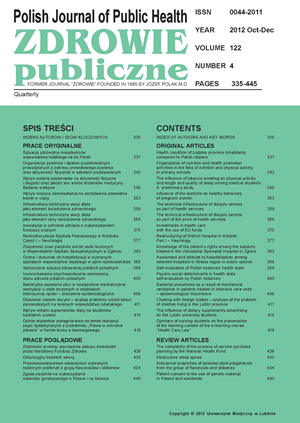Investments in health care with the use of EU funds
DOI:
https://doi.org/10.12923/j.0044-2011/122-4/a.07Keywords:
EU funds, emergency medical services, health care infrastructureAbstract
Introduction. An important element in increasing citizens’ health security is to improve the health infrastructure, the standard of medical equipment and the effectiveness in health emergency. Financial resources from the EU funds turned out to be great support for the health care system. Especially important was the nationwide program Operational Programme Infrastructure and Environment in which one of the priorities directly aimed at strengthening health security and improving the efficiency of the healthcare system in the area of investment in the health care of supra-regional importance, as well as for the broadly understood medical emergency services.
Aim. The aim of this study was to identify and analyze the support for investment in health care and their representation of in the country, resulting from the co-financing from the EU funds from the Operational Programme Infrastructure and Environment (OPIE), Priority 12 called “Health safety and improving the efficiency of the health care system”
Material and methods. Research material consisted of data from the National Information System of the Ministry of Regional Development, a report on the implementation of the Operational Programme Infrastructure and Environment the data of Ministry of Health, available reports, analyses and evaluation studies, and subject literature.
Results. As part of the development of emergency medical services 346 ambulances were purchased, 52 hospital emergency wards and 66 landing sites for rescue helicopters were created or rebuilt. For the treatment of victims with severe injuries, 13 trauma centers for adults were created. In addition, there were purchased 13 170 pieces of equipment and medical apparatus, and 56 treatment facilities of supra-regional importance were expanded or renovated.
Conclusions. EU funds contributed to the improvement of services for patients requiring the assistance in sudden life-threatening conditions and provided the possibility of improving the quality of patient care requiring specialized equipment and medical apparatus, as well as increased the access to highly specialized medical procedures.
References
1. Furtak M, Książek P, Warchoł-Sławińska E, et al. Development of the health care market – forecasts for the future. Zdr Publ. 2011;121(1):76-80.
2. Traktat o funkcjonowaniu Unii Europejskiej (Dz. U. 115 , 09/05/2008 P. 0122-0124).
3. Frączkiewicz-Wronka A, Kotowski P. Inwestycje w zdrowie na poziomie regionu – wykorzystanie funduszy pomocowych do poprawy warunków świadczenia usług zdrowotnych. Warszawa: Oficyna na Wolters Kluwer business; 2010. p.136.
4. Szymańska A. Fundusze unijne i europejskie 2007-2013. Gliwice: Wyd. Złote Myśli; 2006. p. 51-5.
5. Priority 12. Health safety and improvement of the efficiency of the healthcare system, Ministry of Health. Department of European Funds. Warsaw; 2009.
6. Sprawozdanie roczne z realizacji Programu Operacyjnego Infrastruktura i Środowisko 2011. www.mrr.gov.pl.
7. Pigułka dla służby zdrowia – fundusze strukturalne na lata 2007-2013. Warszawa: Ministerstwo Rozwoju Regionalnego; 2008. p.4.
8. Analiza efektów wsparcia w Priorytecie XII PO IiŚ oraz diagnoza potrzeb inwestycyjnych w sektorze ochrony zdrowia, CASE – Doradcy Sp. z o.o. Warsaw, as of 28.12.2011
9. Wpływ interwencji finansowych w ramach Priorytetu XII PO IiŚ na osiągnięcie celów szczegółowych ww. Priorytetu. Katowice: Grupa Gomułka; 2010. p.119.
10. Rozporządzenie Ministra Zdrowia z dnia 18 czerwca 2010 r. w sprawie centrum urazowego (Dz. U. Nr 118, poz. 803).
11. Source: own study based on data from the Ministry of Regional Development of the National Information System as of 30.06.2012.
12. Ustawa z dnia 25 lipca 2001 r. o Państwowym Ratownictwie Medycznym (Dz. U. Nr 113, poz. 1207).
13. Rozporządzenie Ministra Spraw Wewnętrznych i Administracji z dnia 31 lipca 2009 r. w sprawie organizacji i funkcjonowania centrów powiadamiania ratunkowego i wojewódzkich centrów powiadamiania ratunkowego (Dz. U. Nr 130, poz. 1073, z późn. zm.).


